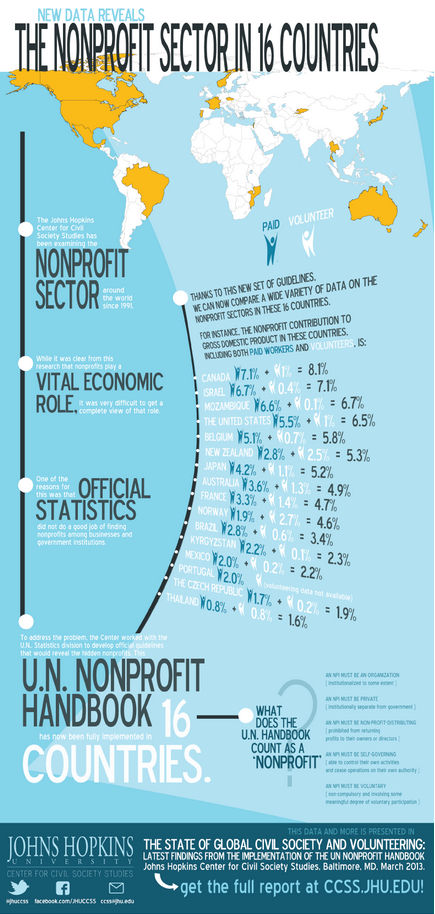The report “The State of Global Civil Society and Volunteering: Latest Findings from the implementation of the U.N. Nonprofit Handbook.” available here, has recently been released. The data in report the result of the implementation of the United Nations Handbook on Nonprofit Institutions in the System of National Accounts. This data sheds new light on the true scope and scale of the nonprofit sector in these countries.
Developed by the Johns Hopkins Center for Civil Society Studies in cooperation with the UN Statistics Division and an International Technical Experts Group, and issued by the U.N. in 2003, this Handbook calls on national statistical offices to produce regular “satellite accounts” on nonprofit institutions and volunteering for the first time, and provides detailed guidance on how to do so. The result is a far more complete official picture of the scope and structure of the nonprofit or civil society sector than has ever been available in these countries.
The report concludes: “The data presented in this report make clear that the nonprofit sector is a considerable economic force and employer, accounting for 10 or more percent of the labor force in a number of countries and contributing a substantial share of the value added to the GDP.In particular fields, the nonprofit role is even more substantial–for example in Portugal, where NPIs account for upwards of 76percent of total value added in social services.”
There were nine key findings:
FINDING 1 The Nonprofit Sector is a major employer: “The nonprofit workforce, including paid and volunteer workers, makes up 7.4 percent of the total workforce on average in the thirteen countries on which full data are available.”
FINDING 2 The Nonprofit Sector is a significant economic presence: “With the value of volunteer work included, nonprofit institutions account for a significant 4.5 percent of gross domestic product (GDP) “
FINDING 3 A fuller picture of Nonprofit Institutions (NPI): “Reflecting this, the full NPI sector seen through the UN NPI Handbook lens is, on average, twice as large as that visible through standard official statistics (3.5 percent vs. 1.7 percent of GDP in the 10 countries for which such comparison is possible”
FINDING 4 Service activities dominate: “The vast majority (nearly 75 percent) of nonprofit gross value added (GVA) is generated through service activities as opposed to expressive activities.”
FINDING 5 NPI share of value added in key fields: “Although the average NPI share of economy-wide gross domestic product (GDP) is 4.5 percent, in the fields in which NPIs operate their GDP contribution is many times larger than this.”
FINDING 6 Nonprofit expenditures: “On average, nonprofit institutions devote the majority of their expenditures to labor costs, as opposed to so-called “intermediate consumption” —the purchase of goods and services from other industries for use in producing output. This likely reflects the fact that these organizations are most heavily engaged in the production of services”
FINDING 7 Composition of NPI contribution to GDP: “Given the service focus of the nonprofit sector and the resulting relatively high share of expenditures that go toward employee compensation, it should come as no surprise that employee compensation also makes up a relatively large share of the NPI contribution to GDP(84 percent vs. 49 percent on average for the rest of the economy).”
FINDING 8 Sources of NPI income: “Fees and charges, not philanthropy, are the major sources of NPI income. Nonprofits derive their revenue from several different sources, which, for the purposes of this report, are grouped into three broad categories: (a) fees charged for the provision of goods and services, (b) government, and (c) philanthropic giving and donations.”
FINDING 9 A growing sector: “Not only is the nonprofit sector a sizable economic presence in countries throughout the world, it is also a growing one. Thus, the GDP contribution of nonprofit institutions in the eight countries for which longitudinal data are available outpaced the growth of the economy overall.”
Find the full report here
Find Handbook on Nonprofit Institutions in the System of National Accounts here

